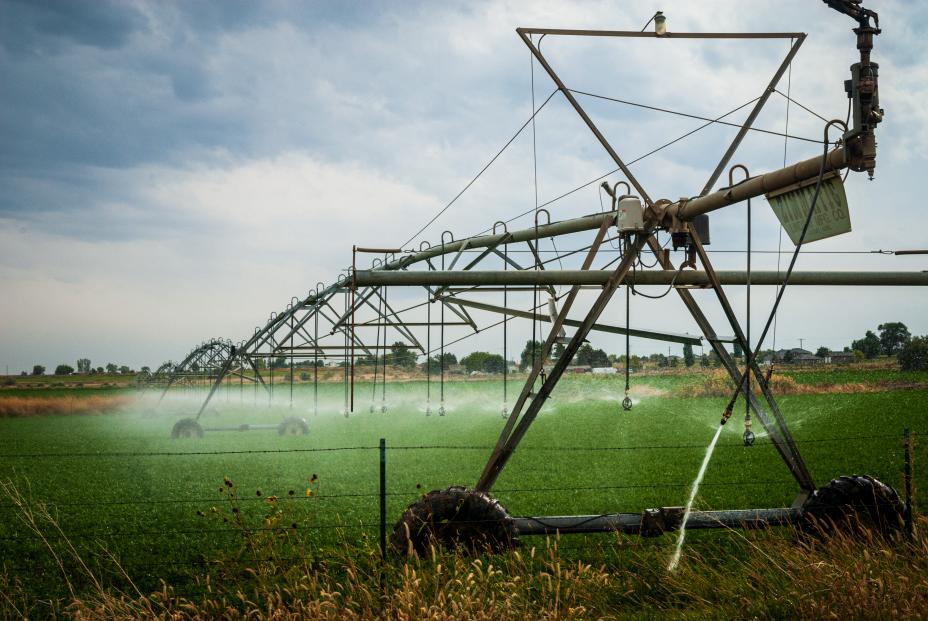National Ecosystem Services Classification System (NESCS) Plus: Case Studies
The National Ecosystems Classification System-Plus (NESCS Plus, pronounced “nex-us plus”) is a robust, step-by-step resource for tracing the links between natural ecosystems and human well-being.
Below are some examples of recent publications that use components of NESCS Plus.
Piloting Ecosystem Accounts for the Southeastern U.S.
 EPA researcher Marc Russell and his collaborators have used NESCS Plus in the first effort to develop Ecosystem Accounts for the U.S. at a broad scale. The team has explored the potential for U.S. ecosystem accounting and explain their pilot accounts for a 10-state region in the Southeast. The pilot accounts address air quality, water quality, biodiversity, carbon storage, recreation, and pollination for selected years from 2001 to 2015. In their study, Testing ecosystem accounting in the United States: A case study for the Southeast, they explain how results can contribute to policy and decision making. For example, in Atlanta they show how ecosystem accounts can help give a more complete picture of a local area’s environmental-economic trends.
EPA researcher Marc Russell and his collaborators have used NESCS Plus in the first effort to develop Ecosystem Accounts for the U.S. at a broad scale. The team has explored the potential for U.S. ecosystem accounting and explain their pilot accounts for a 10-state region in the Southeast. The pilot accounts address air quality, water quality, biodiversity, carbon storage, recreation, and pollination for selected years from 2001 to 2015. In their study, Testing ecosystem accounting in the United States: A case study for the Southeast, they explain how results can contribute to policy and decision making. For example, in Atlanta they show how ecosystem accounts can help give a more complete picture of a local area’s environmental-economic trends.
Source: Warnell, K. J., Russell, M., Rhodes, C., Bagstad, K. J., Olander, L. P., Nowak, D. J., Poudel, R., Glynn, P. D., Hass, J. L., & Hirabayashi, S. (2020). Testing ecosystem accounting in the United States: A case study for the Southeast. Ecosystem Services, 43, 101099.
Who are the Beneficiaries of Great Lakes Waterfront Revitalization?
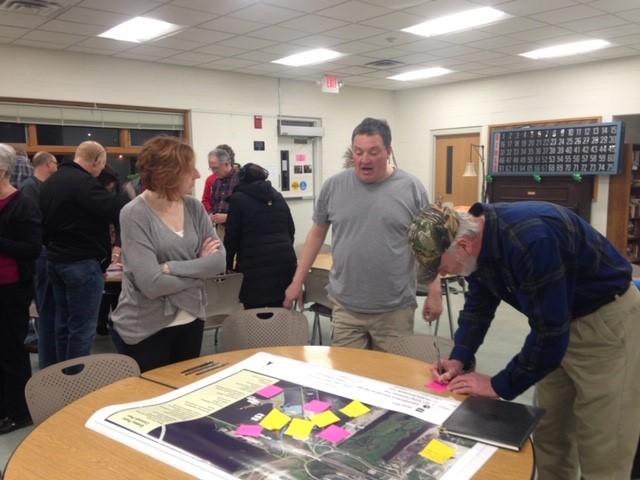 Cleanup of Great Lakes Areas of Concern (AOCs) and other waterfront areas restores environmental benefits to waterfront communities and is essential for revitalization. In the study, Goals, beneficiaries, and indicators of waterfront revitalization in Great Lakes Areas of Concern and coastal communities, multidisciplinary EPA researchers crosswalk waterfront revitalization goals with NESCS Plus Beneficiaries. The also compiled indicators for tracking these goals that that can be used in planning, for comparing alternative designs, and for tracking revitalization progress.
Cleanup of Great Lakes Areas of Concern (AOCs) and other waterfront areas restores environmental benefits to waterfront communities and is essential for revitalization. In the study, Goals, beneficiaries, and indicators of waterfront revitalization in Great Lakes Areas of Concern and coastal communities, multidisciplinary EPA researchers crosswalk waterfront revitalization goals with NESCS Plus Beneficiaries. The also compiled indicators for tracking these goals that that can be used in planning, for comparing alternative designs, and for tracking revitalization progress.
Source: Angradi, T. R., Williams, K. C., Hoffman, J. C., & Bolgrien, D. W. (2019). Goals, beneficiaries, and indicators of waterfront revitalization in Great Lakes Areas of Concern and coastal communities. Journal of Great Lakes Research, 45(5), 851–863. https://doi.org/10.1016/j.jglr.2019.07.001
How Can Recently Developed EPA Tools Help Communities Include Ecosystem Services in Decision Making?
 This synthesis report presents a suite of EPA Sustainable and Healthy Communities research on ecosystem services. The studies summarized in FY18 Output - Incorporation of Ecosystem Goods and Services into Community-Level Decision Support Using EnviroAtlas and Other Tools represent efforts to support community-level decision making by incorporating quantitative information on ecosystem goods and services. This report discusses research to evaluate the utility of decision support tools such as the FEGS-CS classification system (the predecessor to NESCS Plus), the EcoService Models Library (ESML), the EnviroAtlas, Eco-Health Relationship Browser and the FEGS Scoping Tool.
This synthesis report presents a suite of EPA Sustainable and Healthy Communities research on ecosystem services. The studies summarized in FY18 Output - Incorporation of Ecosystem Goods and Services into Community-Level Decision Support Using EnviroAtlas and Other Tools represent efforts to support community-level decision making by incorporating quantitative information on ecosystem goods and services. This report discusses research to evaluate the utility of decision support tools such as the FEGS-CS classification system (the predecessor to NESCS Plus), the EcoService Models Library (ESML), the EnviroAtlas, Eco-Health Relationship Browser and the FEGS Scoping Tool.
Source: Harwell, M., & Jackson, C. (2019). FY18 Output—SHC 2.61.3—Incorporation of Ecosystem Goods and Services into Community-Level Decision Support Using EnviroAtlas and Other Tools (EPA/600/R-19/087). U.S. Environmental Protection Agency.
Mapping Ecosystem Goods and Services: Identifying Linkages in EPA’s EnviroAtlas
 EPA Researcher Paul Ringold and his postdoc Arik Tashie searched the EPA’s EnviroAtlas for useful metrics for Final Ecosystem Goods and Services. They selected the EnviroAtlas because it contains a large fraction of the existing ecological data that is available at a national scale. The researchers investigated linkages between NESCS Plus Environment and Beneficiary classifications and EnviroAtlas data layers. In A critical assessment of available ecosystem services data according to the Final Ecosystem Goods and Services framework, they created a database of over 14,000 linkages between 255 EnviroAtlas data layers. These linkages were classified as intermediate ecosystem goods and services, final ecosystem goods and services, and social or economic outcomes.
EPA Researcher Paul Ringold and his postdoc Arik Tashie searched the EPA’s EnviroAtlas for useful metrics for Final Ecosystem Goods and Services. They selected the EnviroAtlas because it contains a large fraction of the existing ecological data that is available at a national scale. The researchers investigated linkages between NESCS Plus Environment and Beneficiary classifications and EnviroAtlas data layers. In A critical assessment of available ecosystem services data according to the Final Ecosystem Goods and Services framework, they created a database of over 14,000 linkages between 255 EnviroAtlas data layers. These linkages were classified as intermediate ecosystem goods and services, final ecosystem goods and services, and social or economic outcomes.
Source: Tashie, A., & Ringold, P. (2019). A critical assessment of available ecosystem services data according to the Final Ecosystem Goods and Services framework. Ecosphere, 10(3), e02665.
Who Benefits from National Estuaries? Using an Ecosystem Services Classification System to Identify Beneficiaries
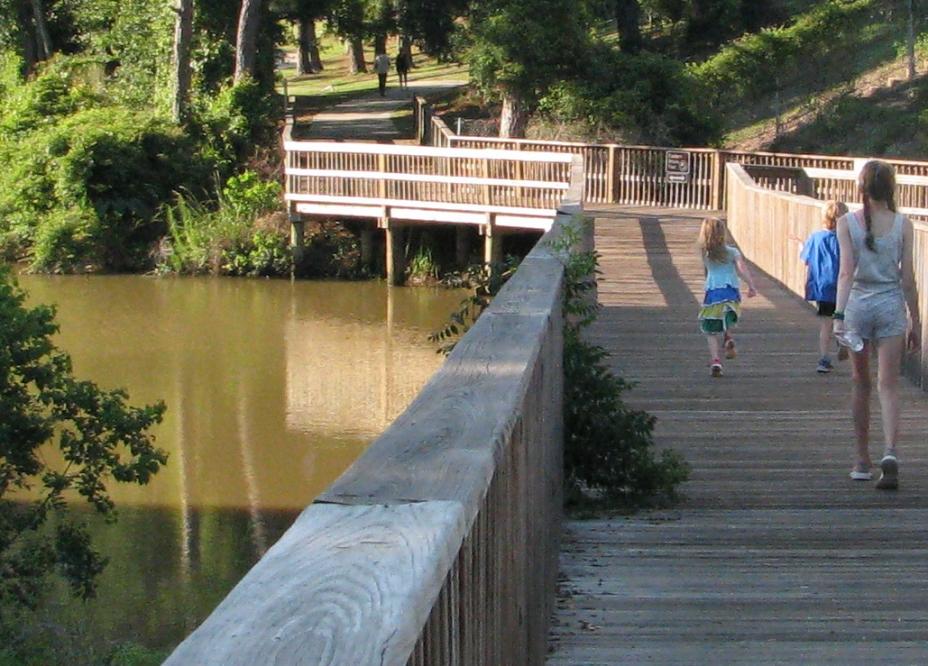 EPA researchers conducted a document analysis of national estuary management plans using the final ecosystem goods and services (FEGS) Classification System (recently updated as NESCS Plus). In Who Benefits from National Estuaries? Applying the FEGS Classification System to Identify Ecosystem Services and their Beneficiaries, they present a suite of ecosystem services relevant to management of National Estuary Programs (NEP) and the National Estuarine Research Reserve System (NERRS), and explicitly link them to the beneficiaries who use them.
EPA researchers conducted a document analysis of national estuary management plans using the final ecosystem goods and services (FEGS) Classification System (recently updated as NESCS Plus). In Who Benefits from National Estuaries? Applying the FEGS Classification System to Identify Ecosystem Services and their Beneficiaries, they present a suite of ecosystem services relevant to management of National Estuary Programs (NEP) and the National Estuarine Research Reserve System (NERRS), and explicitly link them to the beneficiaries who use them.
Source: Yee, S., A. Sullivan, K. Williams, AND K. Winters. 2019. Who Benefits from National Estuaries? Applying the FEGS Classification System to Identify Ecosystem Services and their Beneficiaries. IJERPH 16: 2351 (2019).
How can EnviroAtlas and the Eco-Health Relationship Browser connect decision makers to scientific data?
 Dr. David W. Bolgrien and other EPA researchers use community case studies to demonstrate how the EnviroAtlas and the Eco-Health Relationship Browser serve as gateways between scientific data and decision makers. Successful community problem solving depends on such gateways that facilitate effective communication among partners and make data accessible to establish robust and mutually understandable decisions. In Ecosystem Goods and Services Case Studies and Models Support Community Decision Making using the EnviroAtlas and the Eco-Health Relationship Browser summarizes multiple lines of evidence, analytical tools, models, and data for using ecosystems goods and services in community decision making. Particular emphasis is put on using EPA’s publicly available, web-based EnviroAtlas and Eco-Health Relationship Browser to access EGS data at national and community scales.
Dr. David W. Bolgrien and other EPA researchers use community case studies to demonstrate how the EnviroAtlas and the Eco-Health Relationship Browser serve as gateways between scientific data and decision makers. Successful community problem solving depends on such gateways that facilitate effective communication among partners and make data accessible to establish robust and mutually understandable decisions. In Ecosystem Goods and Services Case Studies and Models Support Community Decision Making using the EnviroAtlas and the Eco-Health Relationship Browser summarizes multiple lines of evidence, analytical tools, models, and data for using ecosystems goods and services in community decision making. Particular emphasis is put on using EPA’s publicly available, web-based EnviroAtlas and Eco-Health Relationship Browser to access EGS data at national and community scales.
Source: Bolgrien, D. W., Angradi, T. R., Bousquin, J., Canfield, T. J., Dewitt, T. H., Fulford, R. S., Harwell, M. C., Hoffman, J. C., Hollenhorst, T. P., Johnston, J. M., Launspach, J. J., Lovette, J., Mckane, R. B., Newcomer-Johnson, T. A., Russell, M. J., Sharpe, L. S., Tashie, A., Williams, K., & Yee, S. H. (2018). Ecosystem Goods and Services Case Studies and Models Support Community Decision Making using the EnviroAtlas and the Eco-Health Relationship Browser. https://doi.org/10.13140/RG.2.2.31113.29286
What are some Practical Strategies for Assessing Final Ecosystem Goods and Services for Community Decision Making?
 This synthesis report describes the U.S. EPA’s Office of Research and Development’s (ORD) research to incorporate the sustainability of final ecosystem goods and services (FEGS) production and benefits into community-scale decisions across the U.S. In FY17 Output SHC 2.61 Practical Strategies for Assessing Final Ecosystem Goods and Services in Community Decision Making, you can learn how community-based studies have previously utilized ecosystem services to inform aspects of their decision making, to identify best practices that may be transferred to other communities, and to identify gaps in those practices that need to be addressed. This report builds upon “Practical Strategies for Integrating Final Ecosystem Goods and Services into Community Decision Making” by Yee et al. (2017) and a number of other deliverables in ORD’s Sustainable Healthy Communities Research Portfolio covering work through FY 17.
This synthesis report describes the U.S. EPA’s Office of Research and Development’s (ORD) research to incorporate the sustainability of final ecosystem goods and services (FEGS) production and benefits into community-scale decisions across the U.S. In FY17 Output SHC 2.61 Practical Strategies for Assessing Final Ecosystem Goods and Services in Community Decision Making, you can learn how community-based studies have previously utilized ecosystem services to inform aspects of their decision making, to identify best practices that may be transferred to other communities, and to identify gaps in those practices that need to be addressed. This report builds upon “Practical Strategies for Integrating Final Ecosystem Goods and Services into Community Decision Making” by Yee et al. (2017) and a number of other deliverables in ORD’s Sustainable Healthy Communities Research Portfolio covering work through FY 17.
Source: Harwell, M., & Jackson, C. (2018). FY17 Output SHC 2.61.3 Practical Strategies for Assessing Final Ecosystem Goods and Services in Community Decision Making (EPA/600/R-18/083). U.S. Environmental Protection Agency.
What Can We Learn from Coordinated Case Studies Across the United States?
 This synthesis report describes the U.S. EPA’s Office of Research and Development’s research to incorporate the sustainability of final ecosystem goods and services production and benefits into community-scale decision-making at several study sites around the U.S. The five case study locations are San Juan, Puerto Rico, Great Lakes Region, Coastal Gulf of Mexico, Pacific Northwest, and Southern Plains Watersheds. The FY16 Output SHC 2.61- Ecosystem Goods and Services Production and Benefit Functions Case Studies Report addresses: (1) how to estimate the production of ecosystem goods and services, given the type and condition of ecosystems; (2) how ecosystem services contribute to human health and well-being; and (3) how the production and benefits of these ecosystem services may change under various decision scenarios and in response to regional conditions.
This synthesis report describes the U.S. EPA’s Office of Research and Development’s research to incorporate the sustainability of final ecosystem goods and services production and benefits into community-scale decision-making at several study sites around the U.S. The five case study locations are San Juan, Puerto Rico, Great Lakes Region, Coastal Gulf of Mexico, Pacific Northwest, and Southern Plains Watersheds. The FY16 Output SHC 2.61- Ecosystem Goods and Services Production and Benefit Functions Case Studies Report addresses: (1) how to estimate the production of ecosystem goods and services, given the type and condition of ecosystems; (2) how ecosystem services contribute to human health and well-being; and (3) how the production and benefits of these ecosystem services may change under various decision scenarios and in response to regional conditions.
Source: Harwell, M., & Molleda, J. (2018). FY16 Output SHC 2.61- Ecosystem Goods and Services Production and Benefit Functions Case Studies Report (EPA/600/R-18/189). U.S. Environmental Protection
Who Benefits from Coastal Habitats?
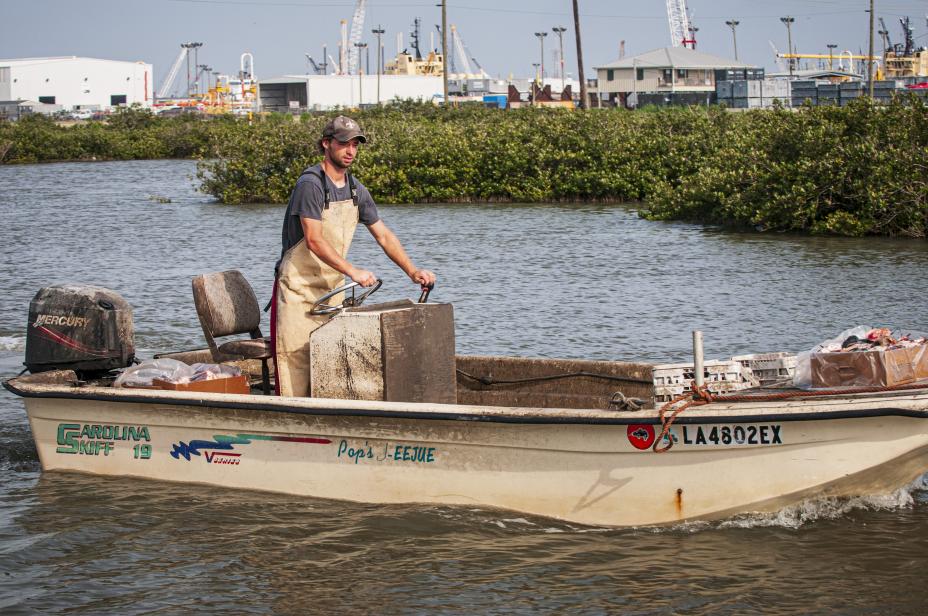 To support coastal communities in land-use planning and prioritization efforts, university scientists and EPA researchers, Theodore DeWitt and Matthew Harwell, examined the state of the science for final ecosystem goods and services (FEGS) in coastal ecosystems. They reviewed ~2,800 studies and documented how various human beneficiaries rely on coastal habitats in Linking people to coastal habitats: A meta-analysis of final ecosystem goods and services on the coast. Recreational (83%) and industrial (35%) users were most cited in literature, with experiential-users/hikers and commercial fishermen most prominent in each category, respectively. This work highlights the intricate relationship between healthy coastal environments and the socio-economic systems they support. The authors hope communities and other stakeholders will couple results from this study with other tools, such as EPA’s EnviroAtlas, to recognize and protect existing FEGS, and plan for future ecosystem service delivery.
To support coastal communities in land-use planning and prioritization efforts, university scientists and EPA researchers, Theodore DeWitt and Matthew Harwell, examined the state of the science for final ecosystem goods and services (FEGS) in coastal ecosystems. They reviewed ~2,800 studies and documented how various human beneficiaries rely on coastal habitats in Linking people to coastal habitats: A meta-analysis of final ecosystem goods and services on the coast. Recreational (83%) and industrial (35%) users were most cited in literature, with experiential-users/hikers and commercial fishermen most prominent in each category, respectively. This work highlights the intricate relationship between healthy coastal environments and the socio-economic systems they support. The authors hope communities and other stakeholders will couple results from this study with other tools, such as EPA’s EnviroAtlas, to recognize and protect existing FEGS, and plan for future ecosystem service delivery.
Source: Littles, C. J., Jackson, C. A., DeWitt, T. H., & Harwell, M. C. (2018). Linking people to coastal habitats: A meta-analysis of final ecosystem goods and services on the coast. Ocean & Coastal Management, 165, 356–369. https://doi.org/10.1016/j.ocecoaman.2018.09.009
How does air pollution impact ecosystem services?
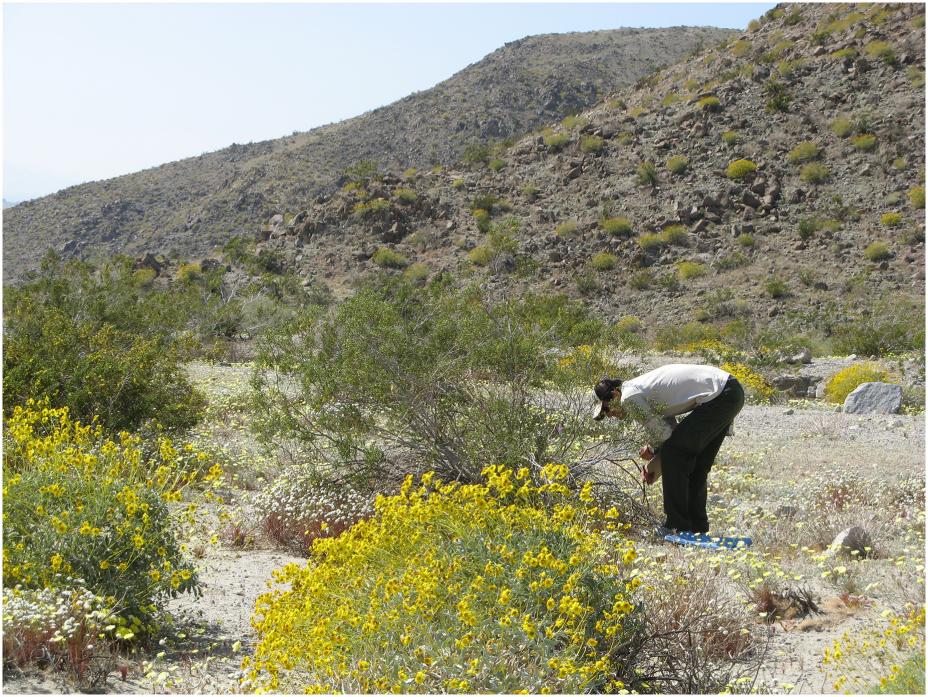 ORD researchers, Dixon Landers, Amanda Nahlik, and Chris Clark, worked together with a team including EPA’s Office of Air and Radiation and Office of Water in a workshop to introduce the STEPS (Stressor–Ecological Production function–final ecosystem Services) Framework, a novel way to apply FEGS-CS as the foundation for identifying difficult and unknown linkages between humans and components of the environment that may lead to human well-being. In A framework to quantify the strength of ecological links between an environmental stressor and final ecosystem services, the examine the ecological impacts of nitrogen and sulfur pollutant emissions and deposition to changes in final ecosystem services. This application is a means of defining a common approach to identify the potential beneficiaries and possible metrics and indicators.
ORD researchers, Dixon Landers, Amanda Nahlik, and Chris Clark, worked together with a team including EPA’s Office of Air and Radiation and Office of Water in a workshop to introduce the STEPS (Stressor–Ecological Production function–final ecosystem Services) Framework, a novel way to apply FEGS-CS as the foundation for identifying difficult and unknown linkages between humans and components of the environment that may lead to human well-being. In A framework to quantify the strength of ecological links between an environmental stressor and final ecosystem services, the examine the ecological impacts of nitrogen and sulfur pollutant emissions and deposition to changes in final ecosystem services. This application is a means of defining a common approach to identify the potential beneficiaries and possible metrics and indicators.
Source: Bell, M. D., Phelan, J., Blett, T. F., Landers, D., Nahlik, A. M., Van Houtven, G., Davis, C., Clark, C. M., & Hewitt, J. (2017). A framework to quantify the strength of ecological links between an environmental stressor and final ecosystem services. Ecosphere, 8(5), e01806. https://doi.org/10.1002/ecs2.1806
Improving the Linkage between Biophysical and Economic Analyses
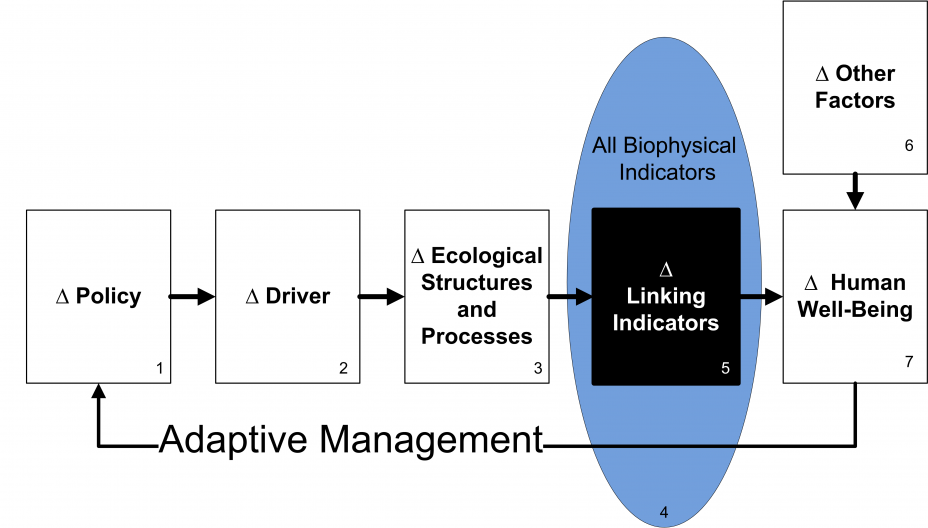
A team of natural and social scientists examined the ways in which ecosystems link to human wellbeing and the way biophysical metrics and indicators should be defined to strengthen that linkage. The paper develops principles to guide the identification of Final Ecosystem Goods and Services (which it refers to as linking indicators); compares their features with those of more commonly collected primarily from the point of view of conducting monetary valuation of ecological outcomes ecological measures; and reviews empirical evidence pertinent to their identification, definition, and performance. The work is divided into several sections. The first is an introduction to the issue. Section 2 of the paper articulates two broad goals that the team argues can help frame the identification of linking indicators. The more obvious of these is the desire for biophysical outcomes that lay audiences can relate clearly to their own well-being. The second goal is to choose indicators that enhance the accuracy of social evaluations. We show how both goals are related to the concept of ecological production. Section 3 describes the deployment of linking indicators in various policy applications. Section 4 identifies research questions pertinent to identification and evaluation of linking indicators and reviews pertinent existing research. Section 5 summarizes the primary findings of the evaluation and offers recommendations for indicator development. This strategy should facilitate collaboration between natural and social scientists; improved understanding, specification, and measurement of linking indicators; and more accurate and powerful environmental policy analysis.
Source: Boyd, J., P. Ringold, A. Krupnick, R. J. Johnston, M. A. Weber, and K. Hall. 2016. Ecosystem Services Indicators: Improving the Linkage between Biophysical and Economic Analyses. International Review of Environmental and Resource Economics 8:359-443.
What Data Should We Collect?
A team of natural and social scientists applied the Final Ecosystem Goods and Services (FEGS) framework to identify metrics and indicators to link changes in policies to changes in human well-being when that linkage is mediated by ecosystems. The six-step process presented enabled the authors to propose metrics associated with streams that can be used in the analysis of human well-being. The team illustrates these steps with data from a regional stream survey. Continued refinement and application of this framework will require ongoing collaboration between natural and social scientists. Application of this framework could result in more useful and relevant data, leading to more informed decisions in the management of ecosystems.
Source: Ringold, P., J. Boyd, D. Landers, and M. Weber. 2013. What Data Should We Collect? A Framework for Identifying Indicators of Ecosystem Contributions to Human Well-Being Frontiers in Ecology and the Environment 11:98-105.

